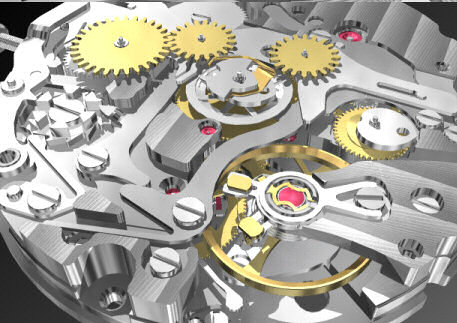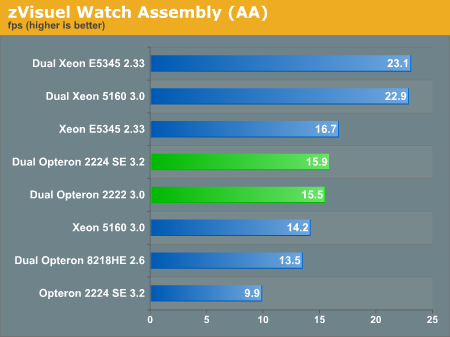Software Rendering
Some of you might remember the "Kribi" engine, an ultra-powerful real-time software rendering 3D engine. It seems like madness to invest time in a software 3D engine now that the GeForce 8800 has 128 small FPUs working at 1.35GHz, but software rendering is far from dead. The new Intel Core architecture can perform up to four 64-bit FP (3 sustained) instructions per clock cycle, and now we have cheap quad cores at 2.4GHz. That is a lot of FP power too, if you carefully optimize for it. That is exactly what the people of zVisuel in Lausanne, Switzerland have been doing. There are quite a few advantages for using software rendering. For example, the end result looks the same on every PC and it runs (although potentially faster or slower depending on hardware) on every PC. That is a big advantage for companies where many people use portables.
If you are still not convinced that real-time software rendering can offer great results, take a look at this movie.

An example what the zVisuel Kribi 3D Engine can create
Eric Bron provided us with a benchmark which is based on real world use by zVisuel's clients. The first benchmark does not use antialiasing.

As we explained here, the new Core architecture has theoretically twice the SSE2 power of the Athlon X2. Extremely carefully optimized SSE2 applications such as the 3D engine of zVisuel show that this leads to a 70% IPC advantage in practice. This shows very nicely why AMD needs the new K10 family: in this case the Athlon 64 architecture is starting to show its age.
We performed the same benchmark, but now antialiasing was applied.

AA clearly makes the application more memory intensive. The two quad core Xeons are only 38% faster than one CPU, while they were 50% faster in the previous benchmark. This helps the Opteron to make the gap a little smaller: the Xeon 3GHz is 48% faster clock for clock, instead of 70%.
Some of you might remember the "Kribi" engine, an ultra-powerful real-time software rendering 3D engine. It seems like madness to invest time in a software 3D engine now that the GeForce 8800 has 128 small FPUs working at 1.35GHz, but software rendering is far from dead. The new Intel Core architecture can perform up to four 64-bit FP (3 sustained) instructions per clock cycle, and now we have cheap quad cores at 2.4GHz. That is a lot of FP power too, if you carefully optimize for it. That is exactly what the people of zVisuel in Lausanne, Switzerland have been doing. There are quite a few advantages for using software rendering. For example, the end result looks the same on every PC and it runs (although potentially faster or slower depending on hardware) on every PC. That is a big advantage for companies where many people use portables.
If you are still not convinced that real-time software rendering can offer great results, take a look at this movie.

An example what the zVisuel Kribi 3D Engine can create
Eric Bron provided us with a benchmark which is based on real world use by zVisuel's clients. The first benchmark does not use antialiasing.

As we explained here, the new Core architecture has theoretically twice the SSE2 power of the Athlon X2. Extremely carefully optimized SSE2 applications such as the 3D engine of zVisuel show that this leads to a 70% IPC advantage in practice. This shows very nicely why AMD needs the new K10 family: in this case the Athlon 64 architecture is starting to show its age.
We performed the same benchmark, but now antialiasing was applied.

AA clearly makes the application more memory intensive. The two quad core Xeons are only 38% faster than one CPU, while they were 50% faster in the previous benchmark. This helps the Opteron to make the gap a little smaller: the Xeon 3GHz is 48% faster clock for clock, instead of 70%.










30 Comments
View All Comments
Spoelie - Monday, August 6, 2007 - link
Thanks for the clarification, I was under the impression the only real states were idle (1ghz) and full tilt (3.2ghz). Never seen any other states but all I ever use are the desktop chips, I wasn't aware CnQ could be more dynamic than that.yuchai - Monday, August 6, 2007 - link
I believe all A64 chips including the desktop ones have the different power states. For example my X2 4200+ has 4 states. 1.0, 1.8, 2.0 and 2.2 Ghz.ButterFlyEffect78 - Monday, August 6, 2007 - link
Are they talking about the barcelona?If not, then this is old news.
I'm sure everyone by now knows that intels new cpu's are better then the current AMD opterons.
KingofFah - Monday, August 6, 2007 - link
It really isn't. The were demonstrating the new 3.2ghz opteron. Also, this was a dual socket setup, and anand said, and everyone who monitors the server world knows, that the opterons come out ahead overall in the 4S environment.The more sockets, the more performance advantage opterons have on intel in the server space. This is well known. The purpose of this was to show it in the dual socket environment.
duploxxx - Monday, August 6, 2007 - link
confused, no it is the stupidity of people like you that think that all Intel offerings are better then the ones for AMD.@anand, you're conclusion of the database world that the quadcore still rules..... where are the benchmarks?
now it is nice to see all these benches next to each other, when are you going to combine benches, no longer servers are used for one application, they are more combined these days with more apps. Maybe its time you also have a look at vmware esx etc.... will probably give you a different look at the offerings of AMD these days.
clairvoyant129 - Monday, August 6, 2007 - link
You don't have to get hostile because he does have a point. In the desktop market, Intel is clearly better unless we're talking about low end. Server market, it's still a toss up but Intel still has a lead.yyrkoon - Monday, August 6, 2007 - link
Um, you guys obviously have not been paying much attention have you ?1) AMD CPUs=cheaper
2) AMD CPUs of comparrible speed perform nearly as good if not as good or better than their Intel counterparts. ie: I think you better check the last benchmarks anandtech post 'homie', because I saw a lot of AMD on top of the game benches. (6000+ vs e6600).
3) Yes, a C2D *may* overclock better, and if it is you intention to overclock, it makes perfect sense to buy one, just be prepared to pay more for the CPU.
4) Up until recently, or possibly still happening into the near future, AMD system boards availible often offered more features for less cost. It does seem however with the P35 Chipset, vendors are starting to come around.
5) last, but not least, THIS article IS NOT about desktop hardware now IS IT ?! why bring some stupid lame ass coment into some place that it does not even fit ? GOd, and I thought I needed a new life . . .
Final Hamlet - Monday, August 6, 2007 - link
It is these "but"s, that make the difference.If they exist, you can't state "all Intel CPUs" anymore, because there are exceptions.
ButterFlyEffect78 - Monday, August 6, 2007 - link
I'm sorry everybody.English is my 2nd language so I sometimes can't always express what I want to say.
What i meant to say is that Intel's new line of cpu's based on Core 2 duo tech. are better-(more advanced) then those based on K8 technology. If this is not true then there should not be a reason to introduce the K10 later this year to counterattack core 2 duo/quad.
But again, I could be wrong.
Calin - Monday, August 6, 2007 - link
Core2Duo technology from Intel is better overall than the K8 technology from AMD - this includes basic architecture, current improvements on the initial architecture (K8 is older and has more of those small improvements), and process/production technology.However, Intel lagged in introduction of Core2 based server processors, and even now their FBDIMM technology is slower and hotter (power hungry) than AMD's Opteron/DDR. Until this changes, AMD still has a market in servers, albeit not as good as before the Core2Duo Xeon processors.